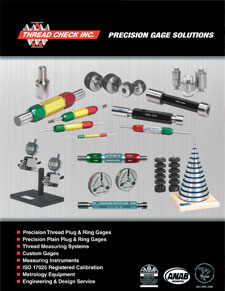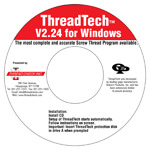Thursday, August 13, 2009
FIXED LIMIT GAGE FACT SHEET
Fixed limit gages are primarily used to check
dimensions and geometries. Plug gages check
internal dimensions and ring gages check external
dimensions. Inspection is performed by use of
GO/NOGO gages that represent the Minimum and
Maximum limit of the product part characteristic to
ensure assembleability and fit. This method is used
for both thread gages and cylindrical plain gages.
GO gages passing through a part assure that the
maximum material condition of a part has not been
exceeded. NOGO gages not passing through the part
assure the dimension has not dropped below the
minimum material condition.
Fixed limit gages are highly accurate, easy to use,
and economical.
HOW TO DETERMINE AND SELECT
THE PROPER TOLERANCE FOR
YOUR GAGING APPLICATION
The normal rule of practice requires 10% of
product tolerance to be divided between the
“ GO “and“ NOGO “ gages. For plug gages, a plus
tolerance is applied to the GO member
and a minus tolerance to the NOGO member. Ring
gages receive reverse tolerance direction so that the
“ GO “ member is minus and the
“ NOGO “ is plus tolerance. Applying this
practice results in gage tolerance always being
included in the part tolerance by up to 10%.
This results in the possibility that 10% of good
product could fail inspection but that no bad product
would ever pass.
When ordering gages, the two basic principles are:
1. Do not allow the tolerance of the GO and NOGO gages to consume more
than 10% of your product tolerance. The 10% is usually divided
equally between the GO and NOGO gages.
2. Higher precision gages will accept slightly more product but with less
wear life and greater expense.
PROPER CARE AND USAGE OF GAGES
• Part dimensions to be gaged should be cleaned and burr free to prevent
gaging interference.
• Gages should be turned or pushed slowly and gently into or onto the
dimension being checked. Forcing gages will result in faulty gaging and
the possibility of damaging both the part and gage.
• The effects of thermal expansion should be taken into consideration on
both the part and the gage. The temperature of the part and the gage
should be the same. 68° F is the ideal temperature at which both part
and gage should be at when inspected because gages are calibrated at
68° F. This effectively eliminates any error due to thermal expansion.
• Protecting gages from excessive heat, moisture and corrosive chemicals
will extend the life of your gages. After use, gages should be cleaned and
recoated with a thin-film rust preventative and stored properly.
• Gages should be periodically inspected and calibrated to assure accuracy.
Go member gages tend to wear quicker with normal use. NOGO gages will
wear on the ends that receive the greatest usage. Frequency of inspection
and calibration should be dependent on such factors as the amount of
usage, part and gage material, tolerance, and quality procedures.
dimensions and geometries. Plug gages check
internal dimensions and ring gages check external
dimensions. Inspection is performed by use of
GO/NOGO gages that represent the Minimum and
Maximum limit of the product part characteristic to
ensure assembleability and fit. This method is used
for both thread gages and cylindrical plain gages.
GO gages passing through a part assure that the
maximum material condition of a part has not been
exceeded. NOGO gages not passing through the part
assure the dimension has not dropped below the
minimum material condition.
Fixed limit gages are highly accurate, easy to use,
and economical.
HOW TO DETERMINE AND SELECT
THE PROPER TOLERANCE FOR
YOUR GAGING APPLICATION
The normal rule of practice requires 10% of
product tolerance to be divided between the
“ GO “and“ NOGO “ gages. For plug gages, a plus
tolerance is applied to the GO member
and a minus tolerance to the NOGO member. Ring
gages receive reverse tolerance direction so that the
“ GO “ member is minus and the
“ NOGO “ is plus tolerance. Applying this
practice results in gage tolerance always being
included in the part tolerance by up to 10%.
This results in the possibility that 10% of good
product could fail inspection but that no bad product
would ever pass.
When ordering gages, the two basic principles are:
1. Do not allow the tolerance of the GO and NOGO gages to consume more
than 10% of your product tolerance. The 10% is usually divided
equally between the GO and NOGO gages.
2. Higher precision gages will accept slightly more product but with less
wear life and greater expense.
PROPER CARE AND USAGE OF GAGES
• Part dimensions to be gaged should be cleaned and burr free to prevent
gaging interference.
• Gages should be turned or pushed slowly and gently into or onto the
dimension being checked. Forcing gages will result in faulty gaging and
the possibility of damaging both the part and gage.
• The effects of thermal expansion should be taken into consideration on
both the part and the gage. The temperature of the part and the gage
should be the same. 68° F is the ideal temperature at which both part
and gage should be at when inspected because gages are calibrated at
68° F. This effectively eliminates any error due to thermal expansion.
• Protecting gages from excessive heat, moisture and corrosive chemicals
will extend the life of your gages. After use, gages should be cleaned and
recoated with a thin-film rust preventative and stored properly.
• Gages should be periodically inspected and calibrated to assure accuracy.
Go member gages tend to wear quicker with normal use. NOGO gages will
wear on the ends that receive the greatest usage. Frequency of inspection
and calibration should be dependent on such factors as the amount of
usage, part and gage material, tolerance, and quality procedures.
Subscribe to:
Post Comments (Atom)


No comments:
Post a Comment